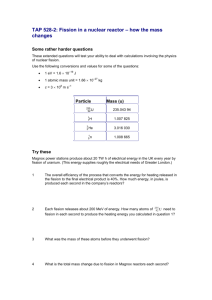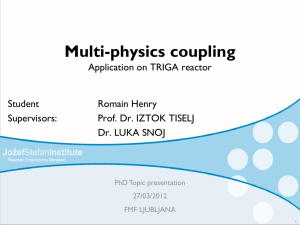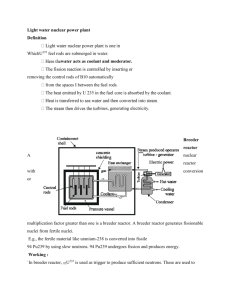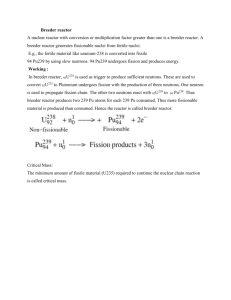A Comparison of Mechanical Advantage and Efficiency Kyle Barefoot Senior Seminar
advertisement
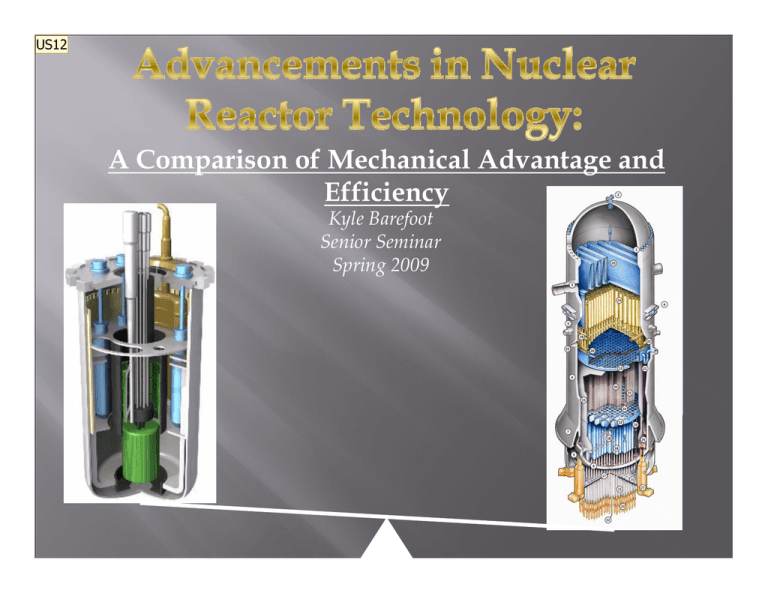
US12 A Comparison of Mechanical Advantage and Efficiency Kyle Barefoot Senior Seminar Spring 2009 A Comparison of Mechanical Advantage and Efficiency • The Basic Physics of Nuclear Physics • Advanced Boiling Water Reactor • S-Prism Reactor • Comparing the ABWR and S-Prism Reactor US14 US15 EXAMPLE: US16 • There must be enough fissile material inside the fuel to maintain the reaction • When this is true the fuel can be said to have reached critical mass; if not enough fissionable material is present then it has subcritical mass Sample chain reaction of U235 US18 Important factors that influence power • The effective nuclear multiplication factor, k, acts as a signifier for the level of reactivity within the reactor • k is defined as the average number of neutrons from one fission that induce another fission US20 CONTROL RODS AND ABSORBERS • A control rod acts as a shield/absorber of neutrons in the reactor and are capable of such because of their chemical make-up • Large capture cross-sections • Do not fission • Helps to control neutron flux • Removed in order to induce chain reactions • Typical material: Boron • Boron alloys Example of CR in a fuel assembly US35 CONTROL RODS AND ABSORBERS • Nuclear/Neutron poisons • Neutron poisons act like control rods, absorbing neutrons without actually fissioning • Poisons can also come from fission products •Example: 135Xe • Removed rods still have about 95% of their original fuel still available that can be used after reprocessing US21 • Reactors can use up to two loops of the same or different material in order to transfer energy (MWth) to turbines that generate power (Mwe) • Circulation is maintained by pumps that regulate the flow of material either to the reactor or to the turbines • Tandem Turbines allow more efficient conversion of power to electricity by utilizing the steam generated by the reactor even after it loses pressure Advanced Boiling Water Reactor (Direct Cycle BWR) US22 • The ABWR employs the process of moderation to transfer and transport energy from the fuel to run the reactor • BWRs are unique because they contain both moderator (water) and vapor inside the reactor core US19 MODERATION • A Neutron Moderator acts as a medium for fast neutrons to transfer energy in the process of becoming thermal neutrons • Most reactors use Light water (H2O) because it has the ability to absorb a large amount of the neutrons energy through collision •Mean logarithmic reduction of neutron energy per collision US23 US3 US27 Moderator • The amount/level of moderator in the core is regulated by RIPs • Regulation is needed in order to control the void coefficient between fuel rods Void Coefficient • Can be used to estimate how the reactivity will change as voids (bubbles) are accumulated within the reactor moderator Fuel assembly Critical Power is also a function of… • Max flux and enthalpy at inlet • Pressure at exit •Axial and radial power distribution US25 Critical Mass • Minimum mass of fissile material • Constant power, temperature, and neutron population in a reactor • Effective neutron multiplication factor, k • k -> average number of neutrons released in a fission that produce another fission • Nuclear reactors run with k=1 US26 Enriched Uranium • Natural/mined Uranium only consists of ~ 0.7% fissile • ABWR requires a higher concentration of fissile material (~5%) • Enrichment process •There are three popular methods to enrich natural Uranium (yellowcake) US28 • ABWRs typically use stainless steel tubes filled with boron carbide (B2C) powder compacted to approximately 75% of theoretical density • The tubes are aligned to form a cross along the blades of a sheath that extend the length of the fuel rods • bottom mounted drive mechanisms US29 Conceptually, 1 loop that extends from RPV to the turbines A Modular Diversion Resistant Fast Reactor US30 Introducing the S-Prism • Utilizing the leftovers • Maintaining a sustainable reaction • Control rods/Neutron Absorbers • Energy transfer US32 Recycled Fuel • Composition of S-Prism fuel is approximately • 10% Zr • 30% Transuranics • the remaining is a mixture of Uranium isotopes of mass 235 and 238 • is a very fertile isotope • Transuranics have a higher efficiency of fissioning in fast reactors US11 • S-Prism is a burner reactor (produces less fissionable material than it uses, k<1) • NO moderator • Neutrons are reflected by circulating sodium back into the reactor fuel • Produce another reaction • Absorbed by transuranics or uranium • Minor actinides have a much higher probability of fissioning when interacting with neutrons of higher energy FAST NEUTRON ~110keV 1MeV THERMAL NEUTRON ~0.075MeV US7 • Screw like design • geometric power distribution • Composed of Boron Carbide • B4C US33 Engineers chose sodium because it does not slow down fast neutrons substantially and because it conducts heat very well, (1)Nuclear fire heats liquid sodium and transfers heat to intermediate sodium (2)Thermal energy/separate loop of sodium (3) Final heat exchanger/steam generator (4) Steam turbines/elec. Producing generators US34 Three main differences: • Use of a moderator • Reactions (Thermal/Fast Neutrons) • Fuel ABWR S-Prism • Light Water (H2O) • No Moderator • Water is relatively the size of neutron particle • Na molecules are comparatively much larger than neutrons • Moderator level helps control the neutron flux • Sodium flow helps control the neutron flux • Thermal energy used to directly change state of moderator and carry energy • Sodium carries thermal energy but does not change state ABWR S-Prism •Thermal neutrons induce fission • Fast neutrons induce fission • Fission produces 1-3 neutrons on average • Fission produces 2-3 neutrons on average • Large absorption cross section of Uranium • transuranics/minor actinides are far more likely to fission • Neutrons transfer a lot of collision energy • Energy comes mostly from gamma radiation ABWR S-Prism • Enriched Uranium • Recycled waste of ABWR • Utilizes ~ 5% of original fuel (95% waste) • Utilizes a majority of original fuel (>90%) • Fuel is manually replaced • Fuel is cycled and replaced by a mechanical arm inside the core • The combined usage of the ABWR and the utilization of its wastes in the S-PRISM provide an unmatched step in helping to close the nuclear fuel cycle • Currently, the presence of an S-Prism reactor would be dependent on the availability of fuel that would be produced by working ABWRs • Both reactors have extreme safety measures that limit the probability of a major problem to almost nothing (~1 per 23 million years) • S-Prism provides more efficient consumption of fuel • Waste • ABWR has potential to provide more energy per reactor • S-Prism complexity is a detour to its usage • Sodium, Fast Neutrons, Energy Transfer • ABWR provides more cost efficient availability Aktas, Birol. BWR and ABWR experience. Wilmingon, September 2008. GE Energy. ABWR General Description. General Description. Wilmington: GE, 2006. —. Advanced Boiling Water Reactor. 1997-2009. Feburary 2009 <http://www.gepower.com/prod_serv/products/nuclear_energy/en/new_reactors/abwr.htm>. —. S-Prism A Modular Diversion Resistant Fast Reactor. Compendium. Wilmington: GE, 2000. NationMaster. Transuranic. 2005. April 2009 <http://www.statemaster.com/encyclopedia/Transuranic>. Nave, R. Nuclear Binding Energy. 2005. Feburary 2009 <http://hyperphysics.phyastr.gsu.edu/hbase/nucene/nucbin.html#c5>. Naves, R. Fast Breeder Reactors. 2005. Feburary 2009 <http://hyperphysics.phyastr.gsu.edu/hbase/NucEne/fasbre.html>. Richard E. Barrans Jr., Ph.D. Transuranic Element Production. March 2009 <http://www.newton.dep.anl.gov/askasci/phy00/phy00094.htm>. U.S. NRC. Uranium Enrichment. 20 September 2007. March 2009 <http://www.nrc.gov/materials/fuel-cycle-fac/urenrichment.html>. Web Elements. Periodic Table of Elements. 2009. March 2009 <http://www.webelements.com/nmr.html>. World Nuclear Association. The Nuclear Fuel Cycle. January 2009. March 2009 <http://worldnuclear.org/info/default.aspx?id=428&terms=uranium>. Y.I. Chang, P.J. Finck, and C. Grandy. Advanced Burner Test Reactor. Preconceptual Design Report. Argonne: Argonne National Labratory, 2006. • Dr. Liping Gan University of North Carolina Wilmington • Arielle Miller Project Manager, GE Hitachi Energy




